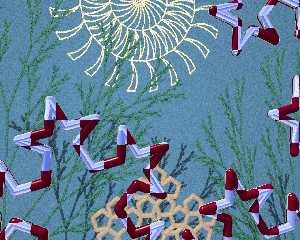>stbenge on date 09/12/2010 19:07 wrote:
> On 12/9/2010 1:08 AM, Paolo Gibellini wrote:
>> Thank you for the interesting images, Sam, I've always been fascinated
>> by IFS: they are simple to write and may conduce to unexpected shapes
>> (the good of iterative algorithms - years ago I made a little 2D IFS
>> parser in POV-Ray).
>> ;-)
>> Paolo
>
> Hi Paolo, I wrote an IFS parser too, hoping to figure out how K-IFS
> fractals work. It didn't really help, but it was a fun diversion <g>
> It's intolerably slow and not very efficient... The attached image took
> 31 seconds to parse, and has 193317 objects from 28 iterations. The
> reference I modeled it from used fewer samples, yet possessed higher
> detail.
>
> Kaleidoscopic iterated function systems, when computed with an escape
> time algorithm, are much more efficient. They take less than a second to
> parse and have a minimal memory footprint... and the result is just one
> object :)
>
> Now if I could just get the Menger Sponge working... I'm about to
> concede defeat :(
Your argumentation are as always convincing ;-), sorry I've no time now
to experiment Kaleidoscopic IFS now.
Paolo
Post a reply to this message
Attachments:
Download 'es_lsystems_20_1280_aa.jpg' (596 KB)
Download 'es_lsystems_08_800_no_aa.jpg' (246 KB)
Preview of image 'es_lsystems_20_1280_aa.jpg'

Preview of image 'es_lsystems_08_800_no_aa.jpg'

|




![]()